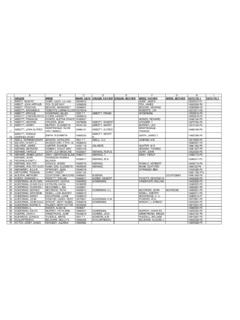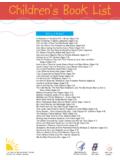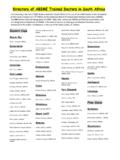Transcription of December 31, 2017 SECTION 1. PURPOSE - irs.gov
1 Initial Guidance Under SECTION 163(j) as Applicable to Taxable Years Beginning After December 31, 2017 Notice 2018-28 SECTION 1. PURPOSE This notice announces that the Department of the Treasury (Treasury Department) and the Internal Revenue Service (IRS) intend to issue proposed regulations providing guidance to assist taxpayers in complying with SECTION 163(j) of the Internal Revenue Code (Code), as amended on December 22, 2017, by An Act to provide for reconciliation pursuant to titles II and V of the concurrent resolution on the budget for fiscal year 2018, 115-97 (the Act). This notice further describes certain of the rules that those proposed regulations will include to provide taxpayers with interim guidance as more comprehensive guidance is developed.
2 The rules described in this notice apply only for purposes of determining the limitation on deductions for interest expense under SECTION 163(j), as amended by the Act. Before the issuance of the regulations described in this notice, taxpayers may rely on the rules described in sections 3 through 7 of this notice. SECTION 2. BACKGROUND Prior to the Act, SECTION 163(j) disallowed a deduction for disqualified interest paid or accrued by a corporation in a taxable year if two threshold tests were satisfied. The first threshold test was satisfied if the payor s debt-to-equity ratio exceeded to (safe harbor ratio).
3 The second threshold test was satisfied if the payor s net - 2 - interest expense exceeded 50 percent of its adjusted taxable income (generally, taxable income computed without regard to deductions for net interest expense, net operating losses, domestic production activities under SECTION 199, depreciation, amortization, and depletion). Disqualified interest for this PURPOSE included interest paid or accrued to: (1) related parties when no Federal income tax was imposed with respect to such interest; (2) unrelated parties in certain instances in which a related party guaranteed the debt; or (3) a real estate investment trust ( REIT ) by a taxable REIT subsidiary of that REIT.
4 Interest amounts disallowed for any taxable year under SECTION 163(j) prior to the Act were treated as interest paid or accrued in the succeeding taxable year and could be carried forward indefinitely. In addition, any excess limitation ( , the excess, if any, of 50 percent of the adjusted taxable income of the payor over the payor s net interest expense) could be carried forward three years. Prior to the Act, SECTION 163(j)(6)(C) provided that [a]ll members of the same affiliated group (within the meaning of SECTION 1504(a)) shall be treated as 1 taxpayer. In addition, SECTION 163(j)(9)(B) provided the Secretary with the authority to issue regulations providing for adjustments in the case of corporations that are members of an affiliated group as may be appropriate for carrying out the purposes of SECTION 163(j).
5 The Report of the Committee on the Budget, House of Representatives, House Report 101-247 at 1248 (Sept. 20, 1989) noted that [i]n cases where a group of commonly controlled corporations would constitute an affiliated group but for the inclusion within the group of one or more entities other than includible corporations (as defined in SECTION 1504(b)), the committee intends for the regulations to treat all corporations that are members of such a group as a single taxpayer where such treatment is - 3 - appropriate in order to carry out the purposes of the bill or to prevent avoidance of the purposes of the bill.
6 Proposed regulations under SECTION 163(j) were issued on June 18, 1991 (Proposed Regulations). 56 FR 27907 (June 18, 1991). The Proposed Regulations contained affiliation rules for SECTION 163(j) purposes (the super-affiliation rules). In particular, proposed (j)-5(a)(2) contained a rule that would treat all members of an affiliated group (as defined in SECTION 1504(a)) as one taxpayer for purposes of SECTION 163(j), without regard to whether such affiliated group files a consolidated return pursuant to SECTION 1501. The Proposed Regulations also contained rules in proposed (j)-5(a)(3) under which, for purposes of SECTION 163(j), if at least 80 percent of the total voting power and total value of the stock of an includible corporation (as defined in SECTION 1504(b)) is owned, directly or indirectly, by another includible corporation, the first corporation would be treated as a member of an affiliated group that includes the other corporation and its affiliates.
7 SECTION 163(j) was amended by the Act to provide new rules limiting the deduction of business interest expense for taxable years beginning after December 31, 2017. See SECTION 13301(a) of the Act. For any taxpayer to which SECTION 163(j) applies, SECTION 163(j)(1) now limits the taxpayer s annual deduction for business interest expense to the sum of: (1) the taxpayer s business interest income (as defined in SECTION 163(j)(6)) for the taxable year; (2) 30 percent of the taxpayer s adjusted taxable income (as defined in SECTION 163(j)(8)) for the taxable year; and (3) the taxpayer s floor plan financing interest (as defined in SECTION 163(j)(9)) for the taxable year.
8 The limitation in SECTION 163(j) applies to all taxpayers, except for certain - 4 - taxpayers that meet the gross receipts test in SECTION 448(c), and to all trades or businesses, except certain trades or businesses listed in SECTION 163(j)(7). SECTION 163(j)(2), as amended by the Act, provides that the amount of any business interest not allowed as a deduction for any taxable year as a result of the limitation in SECTION 163(j)(1) is treated as business interest paid or accrued in the next taxable year and may be carried forward. SECTION 163(j), as amended by the Act, does not provide for the carryforward of any excess limitation.
9 SECTION 163(j)(6)(C), which treated an affiliated group as one taxpayer, and SECTION 163(j)(9)(B), which authorized the super-affiliation rules, were removed by the Act and no equivalent provisions are included in SECTION 163(j), as amended by the Act. The Conference Report to Accompany 1, Report 115-466 (Dec. 15, 2017) (the Conference Report) states in a footnote describing the House Bill that ..a corporation has neither investment interest nor investment income within the meaning of SECTION 163(d). Thus, interest income and interest expense of a corporation is properly allocable to a trade or business, unless such trade or business is otherwise explicitly excluded from the application of the provision.
10 See Conference Report footnote 688, at 386. Nothing in the Conference Report s description of the Senate Amendment or the Conference Agreement is inconsistent with this approach. The Conference Report also notes, in the description of the House Bill, that [i]n the case of a group of affiliated corporations that file a consolidated return, the limitation applies at the consolidated tax return filing level. See Conference Report at 386. Nothing in the Conference Report s description of the Senate Amendment or the Conference Agreement is inconsistent with this approach. However, there is no mention in the Conference Report of applying - 5 - SECTION 163(j) to affiliated groups (within the meaning of SECTION 1504(a)) that do not file a consolidated return.

















